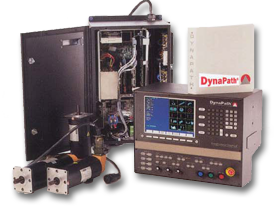
Support FAQ
Axis Tuning
1. How is axis lag displayed on a DynaPath control?
a. Press the 'Mode Select' key, then '5' to enter the Setup mode.
b. Note which test mode is currently highlighted (usually TM0-Normal or TM1-Rapid Override) so that you can return the control to the same test mode when you are done.
c. Press in sequence 'T', 'M', '4', and then 'Enter.' Under 'Test Mode', the line 'TM4-Lag Display' should now be highlighted.
d. Press the 'Mode Select' key, then '0' to enter the Jog mode.
The column which usually displays 'Distance Moved' should now be labeled 'Axis Lag.'
2. How does axis lag information help in tuning axes?
When an axis is jogged at the same speed in both the plus and minus directions, the amount of axis lag displayed should be the same (but with a different sign.) Notice that the amount of lag will vary from machine to machine and is dependent upon how the axis was set up when the machine was commissioned.
Also, to properly cut circles and arcs, the amount of lag at a given velocity on one axis should be the same on the other axis involved. On a mill, this usuallly means X axis lag should be the same as Y axis lag at the same speed. On a lathe, you would look at the X and Z axes.
The amount of lag displayed on an axis that is not moving should, in theory, be zero. In practice, the amount may be 0.0001" or 0.0002", but if it is over 0.0005", the axis drive needs to be balanced. The reason this is the case is that the control checks for "In Position" on all axes at the end of any rapid move. In other words, the lag amount must be less than 0.0005" on all axes at the end of any rapid move.
A machine where one or more drives is out of balance may simply stop moving in the middle of executing a part program. The control will remain in cycle, with no faults displayed. If this condition occurs at the end of a rapid move, it is likely one or more drives need balancing.



